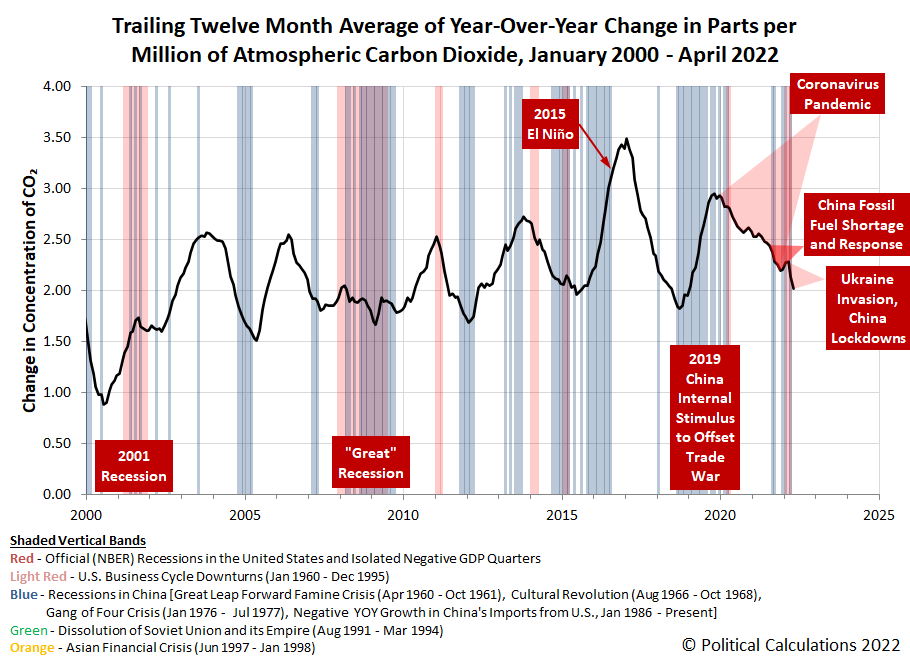The latest view from the volcano points to a higher level of economic gloom for the global economy.
The explanation for that worsening situation is the same as last month: the expanding economic sanctions imposed against Russia following its invasion of Ukraine and, more significantly, China's government's continuing lockdown of Shanghai that threatens to expand to other areas of China.
We're seeing the effects of both situations show up at the remote Mauna Loa Observatory, located atop a volcano on the big island of Hawaii in the middle of the Pacific Ocean, which measures the concentration of carbon dioxide diffused in the Earth's atmosphere. The following chart reveals the sharp, steep decline in the pace at which carbon dioxide is being added to the Earth's atmosphere since February 2022.
The following tool may be used to convert the decline in the rate of CO₂ accumulation into an estimate of the net GDP loss in the global economy associated with it. If you're accessing this article on a site that republishes our RSS news feed, please click through to our site to access a working version of the tool.
Using the default value of a -0.27 parts per million to account for the change in the rate of growth of atmospheric carbon dioxide since February 2022, we find the equivalent net loss to global GDP attributable to the spread of COVID in southeast Asia and to China's fossil fuel shortage is $9.0 trillion. Going back to the beginning of the coronavirus pandemic in December 2019, the reduction of 0.92 part per million in the rate at which carbon dioxide is being added to the Earth's air corresponds to a net loss to global GDP of $30.6 trillion.
Analyst's Notes
We've updated the population data entry in the version of the tool presented above to reflect Earth's estimated 2021 population. Otherwise, the methodology behind the tool is unchanged from when we first introduced it in 2020.
Meanwhile, since we've forayed into planetary level economic analysis, we should note it has been five months since we developed the first-ever estimate of Mars' GDP. We're about a month away from the end of the latest Martian quarter and our next estimate of Mars' GDP, which is coming due because Martian quarters are roughly twice as long as business quarters on Earth.
References
National Oceanographic and Atmospheric Administration. Earth System Research Laboratory. Mauna Loa Observatory CO2 Data. [Text File]. Updated 5 May 2022. Accessed 5 May 2022.
U.S. Central Intelligence Agency. World Factbook. 1 July 2021 Population Estimate (World). [Online Article | Archived Document]. Accessed 8 May 2022.
Labels: environment, gdp, recession, tool
Welcome to the blogosphere's toolchest! Here, unlike other blogs dedicated to analyzing current events, we create easy-to-use, simple tools to do the math related to them so you can get in on the action too! If you would like to learn more about these tools, or if you would like to contribute ideas to develop for this blog, please e-mail us at:
ironman at politicalcalculations
Thanks in advance!
Closing values for previous trading day.
This site is primarily powered by:
CSS Validation
RSS Site Feed
JavaScript
The tools on this site are built using JavaScript. If you would like to learn more, one of the best free resources on the web is available at W3Schools.com.
